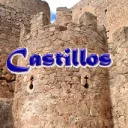• NIEBLA
 Para recorrer esta villa milenaria, que está enclavada sobre una colina que divisa la vega del rio Tinto, y con una murallas que cubren el perímetro de la villa en su totalidad. Destacando su Castillo de los Condes de Niebla y la iglesia de Santa María de la Granada, la que fuera catedral bizantina.
Para recorrer esta villa milenaria, que está enclavada sobre una colina que divisa la vega del rio Tinto, y con una murallas que cubren el perímetro de la villa en su totalidad. Destacando su Castillo de los Condes de Niebla y la iglesia de Santa María de la Granada, la que fuera catedral bizantina.
Puedes efectuar estas visitas:
- Murallas, del S. XII que rodean la ciudad con 1735 m de muros y unos cuarenta torreones. A la entrada esta su Puente Romano
- Puertas muralla, son: la de Sevilla (en la calle Ramón Ortega Egurrola, junto al castillo), la del Socorro (en estas dos aún hay restos romanos) del Buey, del Embarcadero (derrumbada) y la puerta del arco de triunfo o del Agujero. Situándolas en el S. XI.
- Iglesia San Martin, fue la mezquita menor, en los tiempos de la reconquista edificada en la primera mitad del XIII.
- Hospital de Santa María de los Ángeles, originalmente fue templo del S. XIV? que se modifico para convertirse en hospital.
- Iglesia Santa María de la Granada, es una mezcla de mezquita de la localidad del IX e iglesia gótico mudéjar, que se levanto en sucesivas fases los S. XI y XII, XIII, XV y XVI.
- Y el Castillo de los Guzmanes, levantado después de la reconquista en el S. XV sobre lo que era la antigua alcazaba califal sobre restos romanos.
Puedes descargarte el PDF con información, planos, fotos y contactos. Pulsar sobre la imagen con el botón derecho y guardar como…para descargar el archivo PDF para tu tablet o smartphone.
-
NIEBLA
To explore this ancient town, which is nestled on a hill currency vega del rio Tinto, and with walls that cover the perimeter of the village as a whole. Stressing the Castle of the Counts of Niebla and the church of Santa Maria Granada, whichever Byzantine cathedral. You can make these visits:
- Walls, S. XII surrounding the city with 1735 m of walls and towers about forty. At the entrance is the Puente Romano
- Doors wall are: Seville (street Ramón Ortega Egurrola beside the castle), the Relief (these two are still Roman remains) of the Ox, the Embarcadero (collapsed) and door arch of triumph or Hole. Placing them in the S. XI.
- St. Martin Church, was the lowest mosque in the time of the reconquest built in the first half of the thirteenth.
- Hospital of St. Mary of the Angels, was originally Temple S. XIV? that was modified to become hospital.
- St. Mary Church of Granada, is a mixture of the local mosque ninth Mudejar Gothic church, which rose in the successive phases S. XI and XII, XIII, XV and XVI.
- And the Castle of Guzman, built after the conquest in the fifteenth century what was the ancient citadel of Roman remains Caliphate.
You can download the PDF with information, maps, photos and contacts. Click on the image with the right mouse button and save as … to download the PDF file to your tablet or smartphone.
-
NIEBLA
Pour explorer cette ville antique, qui est niché sur une colline de monnaie vega del rio Tinto, et avec des murs qui couvrent le périmètre du village dans son ensemble. Soulignant le château des comtes de Niebla et l’église de Santa Maria Grenade, selon cathédrale byzantine. Vous pouvez effectuer ces visites:
- Murs, S. XII autour de la ville avec 1735 m de murs et de tours environ quarante. A l’entrée, le Puente Romano
- Portes mur sont: Séville (rue Ramón Ortega Egurrola à côté du château), l’Office de secours (ces deux sont encore des vestiges romains) du Buffle, l’Embarcadero (réduit) et porte arc de triomphe ou trou. Les placer dans le S. XI.
- Église Saint-Martin, était la mosquée la plus faible dans le temps de la reconquête construit dans la première moitié du XIIIe.
- Hôpital de Sainte-Marie des Anges, était à l’origine Temple S. XIV? qui a été modifié pour devenir hôpital.
- Eglise Sainte-Marie de Grenade, est un mélange de la mosquée neuvième église gothique mudéjar locale, qui a augmenté dans les phases successives S. XI et XII, XIII, XV et XVI.
- Et le château de Guzman, construit après la conquête au XVe siècle ce qui était l’ancienne citadelle de vestiges romains califat.
Vous pouvez télécharger le PDF avec des informations, des cartes, des photos et des contacts. Cliquez sur l’image avec le bouton droit de la souris et enregistrer sous … pour télécharger le fichier PDF sur votre tablette ou smartphone.
-
NIEBLA
Um diese alte Stadt, die auf einem Hügel Währung Vega del Rio Tinto eingebettet ist zu erforschen und mit Wänden, die den Umfang des Dorfes als Ganzes zu decken. Betonung der Burg der Grafen von Niebla und der Kirche Santa Maria Granada, je nachdem, welcher byzantinische Kathedrale. Sie können diese Besuche zu machen:
- Wände, S. XII die Stadt mit 1.735 m der Mauern und Türme über vierzig Umgebung. Am Eingang befindet sich die Puente Romano
- Türen Wand sind: Sevilla (Straße Ramón Ortega Egurrola neben der Burg), dem Relief (diese beiden sind immer noch die römischen Überreste) der Ochse, der Embarcadero (zusammengeklappt) und Türtriumphbogen oder Hole. Stellt man diese in der S. XI.
- St.-Martin-Kirche, war die niedrigste Moschee in der Zeit der Rückeroberung in der ersten Hälfte des dreizehnten gebaut.
- Krankenhaus St. Maria von den Engeln, war ursprünglich Temple S. XIV? wurde modifiziert, dass ein Krankenhaus geworden.
- St.-Maria-Kirche von Granada, ist eine Mischung aus der örtlichen Moschee neunten Mudéjar-gotische Kirche, die in den aufeinanderfolgenden Phasen S. XI und XII, XIII, XV und XVI Rose.
- Und das Schloss von Guzman, nach der Eroberung im fünfzehnten Jahrhundert, was war die alte Zitadelle von Roman gebaut bleibt Kalifat.
Sie können die PDF-Datei mit Informationen, Karten, Fotos und Kontakte herunterladen. Klicken Sie auf das Bild mit der rechten Maustaste und speichern unter …, um die PDF-Datei auf Ihrem Tablet oder Smartphone herunterladen.

 castillode.wordpress.com
castillode.wordpress.com museode.wordpress.com
museode.wordpress.com
Deja un comentario